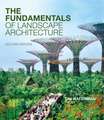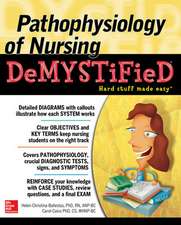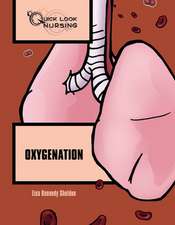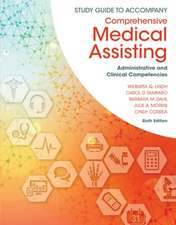Fundamentals of Person–Centred Healthcare Practice: Fundamentals
Autor B McCormacken Limba Engleză Paperback – 3 feb 2021
Din seria Fundamentals
- 7%
 Preț: 195.38 lei
Preț: 195.38 lei - 13%
 Preț: 204.45 lei
Preț: 204.45 lei - 19%
 Preț: 224.89 lei
Preț: 224.89 lei - 5%
 Preț: 321.64 lei
Preț: 321.64 lei - 13%
 Preț: 201.77 lei
Preț: 201.77 lei - 13%
 Preț: 196.29 lei
Preț: 196.29 lei - 5%
 Preț: 313.49 lei
Preț: 313.49 lei -
 Preț: 223.98 lei
Preț: 223.98 lei - 5%
 Preț: 258.65 lei
Preț: 258.65 lei - 5%
 Preț: 250.35 lei
Preț: 250.35 lei - 13%
 Preț: 196.29 lei
Preț: 196.29 lei - 20%
 Preț: 220.75 lei
Preț: 220.75 lei - 5%
 Preț: 292.20 lei
Preț: 292.20 lei - 5%
 Preț: 348.11 lei
Preț: 348.11 lei - 5%
 Preț: 305.00 lei
Preț: 305.00 lei - 7%
 Preț: 202.22 lei
Preț: 202.22 lei - 5%
 Preț: 353.13 lei
Preț: 353.13 lei - 5%
 Preț: 296.92 lei
Preț: 296.92 lei -
 Preț: 275.81 lei
Preț: 275.81 lei - 5%
 Preț: 335.86 lei
Preț: 335.86 lei - 5%
 Preț: 234.76 lei
Preț: 234.76 lei - 23%
 Preț: 193.29 lei
Preț: 193.29 lei - 5%
 Preț: 302.46 lei
Preț: 302.46 lei - 7%
 Preț: 195.31 lei
Preț: 195.31 lei - 22%
 Preț: 202.40 lei
Preț: 202.40 lei - 5%
 Preț: 306.75 lei
Preț: 306.75 lei - 7%
 Preț: 155.40 lei
Preț: 155.40 lei - 5%
 Preț: 263.94 lei
Preț: 263.94 lei - 5%
 Preț: 308.90 lei
Preț: 308.90 lei - 5%
 Preț: 292.93 lei
Preț: 292.93 lei - 5%
 Preț: 291.55 lei
Preț: 291.55 lei - 20%
 Preț: 221.13 lei
Preț: 221.13 lei - 13%
 Preț: 189.91 lei
Preț: 189.91 lei - 5%
 Preț: 348.74 lei
Preț: 348.74 lei - 26%
 Preț: 235.11 lei
Preț: 235.11 lei - 5%
 Preț: 264.76 lei
Preț: 264.76 lei - 5%
 Preț: 333.69 lei
Preț: 333.69 lei - 37%
 Preț: 169.79 lei
Preț: 169.79 lei - 22%
 Preț: 189.91 lei
Preț: 189.91 lei - 18%
 Preț: 198.50 lei
Preț: 198.50 lei
Preț: 297.27 lei
Preț vechi: 312.91 lei
-5% Nou
Puncte Express: 446
Preț estimativ în valută:
56.90€ • 61.83$ • 47.83£
56.90€ • 61.83$ • 47.83£
Carte disponibilă
Livrare economică 31 martie-14 aprilie
Livrare express 15-21 martie pentru 48.26 lei
Preluare comenzi: 021 569.72.76
Specificații
ISBN-13: 9781119533085
ISBN-10: 1119533082
Pagini: 384
Dimensiuni: 179 x 254 x 22 mm
Greutate: 0.8 kg
Editura: Wiley
Seria Fundamentals
Locul publicării:Chichester, United Kingdom
ISBN-10: 1119533082
Pagini: 384
Dimensiuni: 179 x 254 x 22 mm
Greutate: 0.8 kg
Editura: Wiley
Seria Fundamentals
Locul publicării:Chichester, United Kingdom
Cuprins
List of contributors xvii Foreword xxi Acknowledgement xxiii Editor Biographies xxv Introduction xxvii Section 1 The Person in Person-Centred Practice 1 Chapter 1 The person in person-centred practice 3 Brendan McCormack, Tanya McCance, and Jan Dewing Introduction 4 Who am I? 4 What does it mean to be a person? 6 Personhood 7 Persons, personhood and person-centred practice 10 Conclusion 10 Summary 11 References 11 Further reading 11 Chapter 2 What is person-centredness? 13 Brendan McCormack, Tanya McCance, and Suzanne Martin Introduction 14 The values of person-centredness 15 Person-centredness and related concepts 16 Person-centred practice 17 Person-centred culture 19 Conclusions 20 Summary 20 References 21 Further reading 22 Chapter 3 The Person-centred Practice Framework 23 Tanya McCance and Brendan McCormack Introduction 24 What is person-centred practice? 24 Introducing the Person-centred Practice Framework 25 Prerequisites 26 The practice environment 27 Person-centred processes 29 Person-centred outcomes 29 Applying the framework in practice 30 Conclusions 30 Summary 30 References 31 Further reading 32 Chapter 4 Knowing self 33 Donna Brown and Savina Tropea Introduction 34 Understanding and defining self: different perspectives 34 Different aspects of self 35 The journey through 'knowing self': tools and approaches 36 The importance of self-knowledge for developing healthful cultures 37 Using reflection to know self 38 Creating the conditions to know self and others 38 Conclusion 39 Summary 39 References 40 Chapter 5 Flourishing as humans 41 Brendan McCormack, Tanya McCance, and Jan Dewing Introduction 42 What is human flourishing? 43 Conditions for human flourishing 45 A resting place 49 Summary 49 References 50 Further reading 50 Chapter 6 Professionalism and practising professionally 51 Caroline Gibson, Kath MacDonald, and Deirdre O'Donnell Introduction 52 Practising professionally 52 Standards for professional practice 53 Maintaining professional standards 54 Legal and ethical responsibilities 55 Person-centredness, professionalism and organisational structures 56 Creating person-centred cultures 57 Conclusion 58 Summary 58 References 60 Chapter 7 The future nurse, midwifery and allied health professional 61 Suzanne Martin, Charlotte McArdle, and Ed Jesudason Introduction 62 Professionalism and person-centredness 63 Step 1 - Build the initial team 65 Step 2 - Identify what we can do 65 Step 3 - Co-create the vision 65 Step 4 - Co-design the solution 65 Step 5 - Co-delivery 66 Step 6 - Co-evaluate 66 Challenges to professionalism 66 Curricula content 67 Conclusion 69 Summary 69 Acknowledgements 70 References 70 Further reading 70 Section 2 Being Person-centred 71 Chapter 8 Communicating and relating effectively 73 Duncan Pentland, Helen Riddell, and Lindsey Regan Introduction 74 Framing communication - definitions and basic concepts 75 Fundamental ideas in person-centred communication 76 Strategies for putting person-centred communication into action 79 Conclusion 80 Summary 81 References 81 Further reading 81 Chapter 9 Systems to support person-centred decision making 83 Amanda Stears and Dawn Jansch Introduction 84 What is decision making? 84 Service user perspectives 86 Person-centred decision making 87 The value of shared decision making 88 Multidisciplinary team 88 Organisational decision making 90 Summary 91 References 92 Further reading 92 Chapter 10 Connecting with others 93 Brighide Lynch, Derek Barron, and Lesley McKinlay Introduction 94 Relationship with self: emotional intelligence 95 Relationship with colleagues 97 Relationships with the person and their family 98 Conclusion 100 Summary 100 References 100 Further reading 101 Chapter 11 The physical environment 103 Suzanne Martin, Assumpta Ryan, and Fiona Maclean Introduction 104 Ward layout and room type 105 Acoustic environment (noise reduction) 105 Lighting (natural daylight and artificial light) 106 Views, exposure and access to nature 106 How can a better environment be provided to service users? 109 Conclusion 110 Summary 110 References 110 Further reading 111 Chapter 12 Working with persons' beliefs and values 113 Suzanne Martin, Lisa Luhanga, and Catherine Wells Introduction 114 Beliefs, values and person-centredness 114 Personal beliefs and values 115 Professional values 115 Respecting all beliefs and values 116 Contemporary considerations and challenges 117 Beliefs and values in person-centred practice 118 Conclusion 119 Summary 119 References 119 Further reading 120 Chapter 13 Engaging meaningfully and effectively 121 Ailsa Espie, Georgios Tsigkas, and Donna Brown Introduction 122 Engaging authentically 122 Levels of engagement 123 Human agency and reflexivity 124 Challenging the status quo and non-person-centred practices 125 Conclusion 126 Summary 127 References 127 Further reading 127 Chapter 14 Sharing in decisions 129 Jean Daly Lynn, Assumpta Ryan, and Fiona Kelly Introduction 130 Shared decision making with service users 130 Shared decision making in action 131 Opportunities and challenges with shared decision making 133 Shared decision making and cognitive impairment 135 Conclusion 136 Summary 137 References 137 Further reading 138 Chapter 15 Being sympathetically present 139 Tanya McCance, Brendan McCormack, Karl Tizzard-Kleister, and Lynn Wallace Introduction 140 Understanding sympathetic presence 141 Being present in the moment 143 Conclusion 145 Summary 145 References 146 Further reading 146 Chapter 16 Providing holistic care 147 Neal F. Cook and Michelle L. Elliot Introduction 148 The concept of holism 149 People, healthcare and holism 150 Factors influencing holistic provision of care 151 Providing holistic care 152 Upholding the holistic gaze 153 Conclusion 155 Summary 155 References 156 Further reading 156 Section 3 Person-Centredness in Health and Social Care Systems 157 Chapter 17 Sociopolitical context in person-centred practice 159 Deborah Baldie, Tanya McCance, and Brendan McCormack Introduction 160 Strategic leadership 160 Health and social care policy 161 Strategic frameworks 162 Workforce developments 163 Conclusion 166 Summary 167 References 167 Further reading 168 Chapter 18 Being person-centred in the acute hospital setting 169 Christine Boomer, Bill Lawson, and Robert Brown Introduction 170 An overview of person-centredness in the acute hospital setting 170 Person-centred moments versus consistent person-centred practice 171 The impact of the practice environment on person-centredness in acute settings 172 How can we move beyond person-centred moments in acute hospital settings? 174 Conclusion 175 Summary 176 References 176 Further reading 177 Chapter 19 Person-centred rehabilitation 179 Jackie Gracey and Ailsa McMillan Introduction 180 What is rehabilitation? 181 Who can participate in person-centred rehabilitation? 183 Person-centred processes 184 Conclusion 187 Summary 187 References 188 Further reading 188 Chapter 20 Being person-centred in community and ambulatory services 189 Caroline Dickson and Lorna Peelo-Kilroe Introduction 190 The rich learning environments in community contexts 191 Knowing what matters to you being in the community 191 Stepping stones to enable you to be your best self in practice 193 Community contexts as flourishing workplaces 194 Conclusion 196 Summary 196 References 197 Further reading 197 Chapter 21 Experiencing person-centredness in long-term care 199 Kevin Moore and Fiona Kelly Introduction 200 Residential and long-term care: supporting quality of life 201 Choosing the right long-term care setting and holding that difficult conversation 202 The transition from 'home' to 'home' 203 Nursing and caring expertise in residential care settings 204 Dignity and the importance of effective communication and interpersonal skills 205 Conclusion 206 Summary 206 References 207 Further reading 208 Chapter 22 Being person-centred in mental health services 209 David Banks, Josianne Scerri, and Jessica Davidson Introduction 210 How rights-based approaches can inform person-centred care of people experiencing mental distress 210 Implementing the Person-centred Practice Framework in the context of mental distress and trauma informed practice 213 The necessity of developing a shared understanding 216 Story telling as a means of therapeutic engagement 216 Conclusion 217 Summary 217 References 218 Chapter 23 Person-centred support for people with learning disabilities 219 Owen Barr, Martina Conway, and Vidar Melby Introduction 220 Definition of a person with a learning disability 221 Person-centred principles that have underpinned services for people with learning disabilities 222 The ongoing need for a person-centred framework that is evidenced in practice 223 Delivering person-centred health and social care services for people with learning disabilities 224 Conclusion 227 Summary 227 References 228 Further reading 228 Chapter 24 Being person-centred in maternity services 229 Honor MacGregor and Patricia Gillen Introduction 230 Contemporary maternity care 230 Being professionally competent as a midwife 231 Power sharing in person-centred maternity care 232 Enabling person-centred maternity care through shared decision making 233 Conclusion 234 Summary 235 References 235 Further reading 236 Chapter 25 Being person-centred in children's services 237 Ruth Magowan and Brian McGowan Introduction 238 Person-centred processes 239 Working with the person's beliefs and values 240 Engaging authentically 240 Sharing decision making 241 Being sympathetically present 242 Working holistically 242 Conclusion 244 Summary 245 References 245 Further reading 246 Chapter 26 Being person-centred when working with people living with long-term conditions 247 Anne Williams, Suzanne Martin, and Vivien Coates Introduction 248 The context and challenges of living with a long-term condition 248 Healthcare system design 249 Supporting people with long-term conditions 251 Assessment in the context of providing holistic care 253 Critical perspectives 254 Conclusion 255 Summary 255 References 255 Further reading 256 Chapter 27 Palliative and end of life care services 257 Antonia Lannie, Erna Haraldsdottir, and Juliet Spiller Introduction 258 Key strategic drivers reflecting the person-centred macro context of palliative care 259 Prerequisites: being a person-centred practitioner in palliative care 259 The context of palliative care and person-centred practice 261 Person-centred processes in palliative care 262 Challenges to person-centred outcomes in palliative care 263 Summary 264 References 264 Further reading and resources 265 Section 4 Approaches to Learning and Development for Person-Centred Practice 267 Chapter 28 Being an active learner 269 Jan Dewing and Brighide Lynch Introduction 270 What is active learning? 270 Our primary senses as the foundation for learning 271 Multiple intelligences 271 What makes active learning necessary for human flourishing? 272 Active learning and the Person-centred Practice Framework 273 Active learning in class-based learning 274 Active learning in the workplace 274 Conclusion 277 Summary 277 References 277 Further reading 278 Chapter 29 Knowing and becoming through reflective learning 279 Donna Brown and Kristina Mountain Introduction 280 Reflection for person-centred practice 280 In pursuit of knowing and becoming 281 Creating communicative spaces 282 Working with the challenges of knowing and becoming 284 Linking knowing and becoming to experiences from practice 284 Creating the conditions for knowing and becoming 285 Conclusion 286 Summary 286 References 287 Further reading 287 Chapter 30 Becoming a critical thinker 289 Neal F. Cook, Sonyia McFadden, and Lindsey Regan Introduction 290 What is critical thinking? 290 The importance of critical thinking in practice 291 Enablers and inhibitors of critical thinking 293 The journey of becoming and being a critical thinker 295 Understanding self in becoming and being a critical thinker 296 Conclusion 296 References 297 Further reading 297 Chapter 31 Developing and supporting practice educators 299 Fiona Stuart, Lucia Ramsey, and Jacinta Lynch Introduction 300 Person-centred learning cultures 301 Learning processes 302 Evaluation processes 304 Evaluating your role and responsibility 305 Summary 306 References 306 Further reading 307 Chapter 32 Being curious through research and knowledge exchange 309 Cathy Bulley, Margaret Smith, and Alison Williams Introduction 310 Person-centred values and principles in research and knowledge exchange 311 Starting off: developing ideas for research and knowledge exchange through conversation 311 Continuing: developing ways of addressing research questions and knowledge exchange topics 313 Moving forward: ensuring that our work has positive impacts on people 315 Conclusion 316 Summary 316 References 316 Further reading 317 Chapter 33 Being a lifelong learner 319 Lindesay Irvine, Patricia Gillen, and Owen Barr Introduction 321 Lifelong learning and its relationship to person-centredness 321 Practice learning as adult learners 326 How we learn, and its effect on practice learning 327 Developing reflexivity in learning 328 Conclusion 329 Summary 329 References 330 Further reading 330 Chapter 34 The future of person-centred practice - a call to action! 331 Brendan McCormack, Tanya McCance, Donna Brown, Cathy Bulley, Ailsa McMillan, and Suzanne Martin The need for conceptual and theoretical clarity 332 The KISS Principle 335 Resting place 336 References 336 Index 339
Notă biografică
ABOUT THE EDITORS Brendan McCormack is Head of the Division of Nursing, Occupational Therapy and Art Therapies; Associate Director, Centre for Person-centred Practice Research, Queen Margaret University, Edinburgh, Scotland; and Honorary Nurse Consultant, Erskine Care, Scotland. Tanya McCance is Mona Grey Professor of Nursing, Institute of Nursing and Health Research, Ulster University, Northern Ireland; Adjunct Professor, University of Wollongong, Australia; and Visiting Professor, Queen Margaret University, Edinburgh, Scotland. Cathy Bulley is a Reader in the School of Health Sciences at Queen Margaret University, Edinburgh, Scotland; Co-Director of the Centre for Health, Activity and Rehabilitation Research (CHEARR); and Lead for the Accelerating Scholarship, Innovation and Research Engagement (DPPR-ASPIRE). Donna Brown is a Lecturer of Nursing, Postgraduate Tutor for the Institute of Nursing and Health Research, and Course Director for BSc(Hons)/PGDip/MSc Developing Practice in Healthcare Programme, in the School of Nursing, Ulster University, Northern Ireland. Ailsa McMillan is a Senior Lecturer of Nursing, Division of Nursing, Queen Margaret University, Edinburgh, Scotland. Suzanne Martin is a Professor of Occupational Therapy and Head of School Health Sciences at Ulster University, Northern Ireland. She is a Fellow of the College of Occupational Therapists UK and a panel member for the National Institute for Health Research.

















